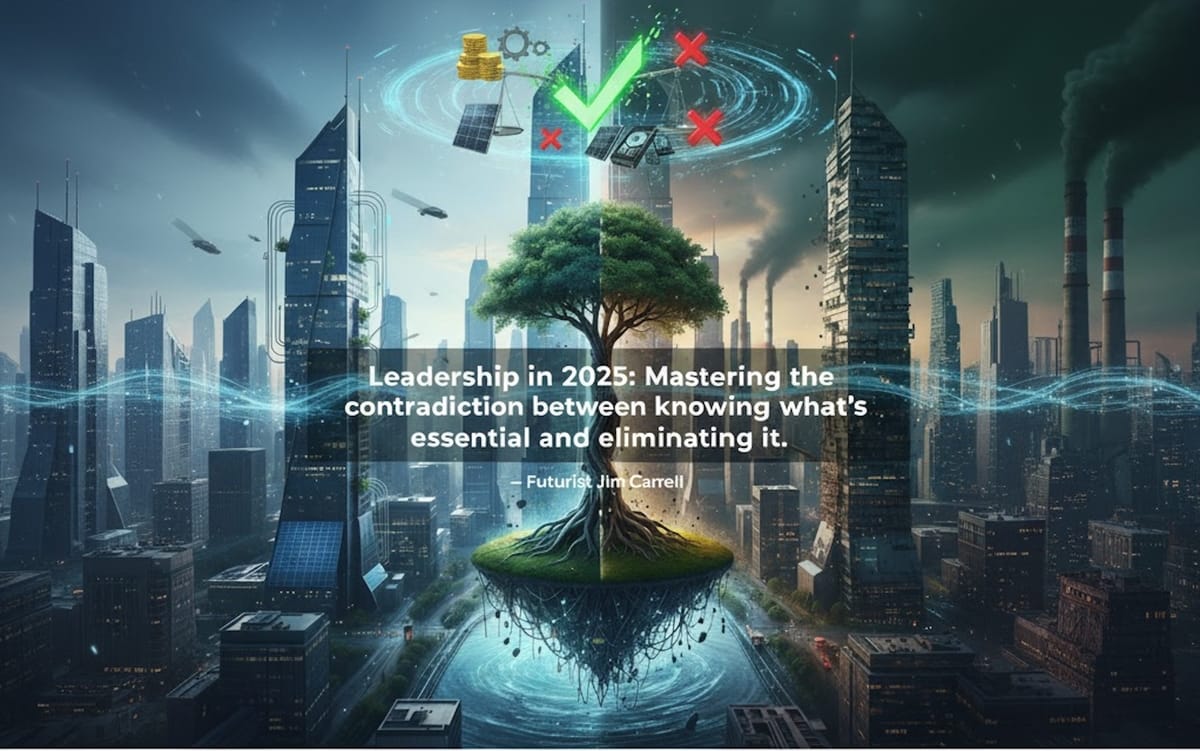"Leadership in 2025: Mastering the contradiction between knowing what's essential and eliminating it." - Futurist Jim Carroll
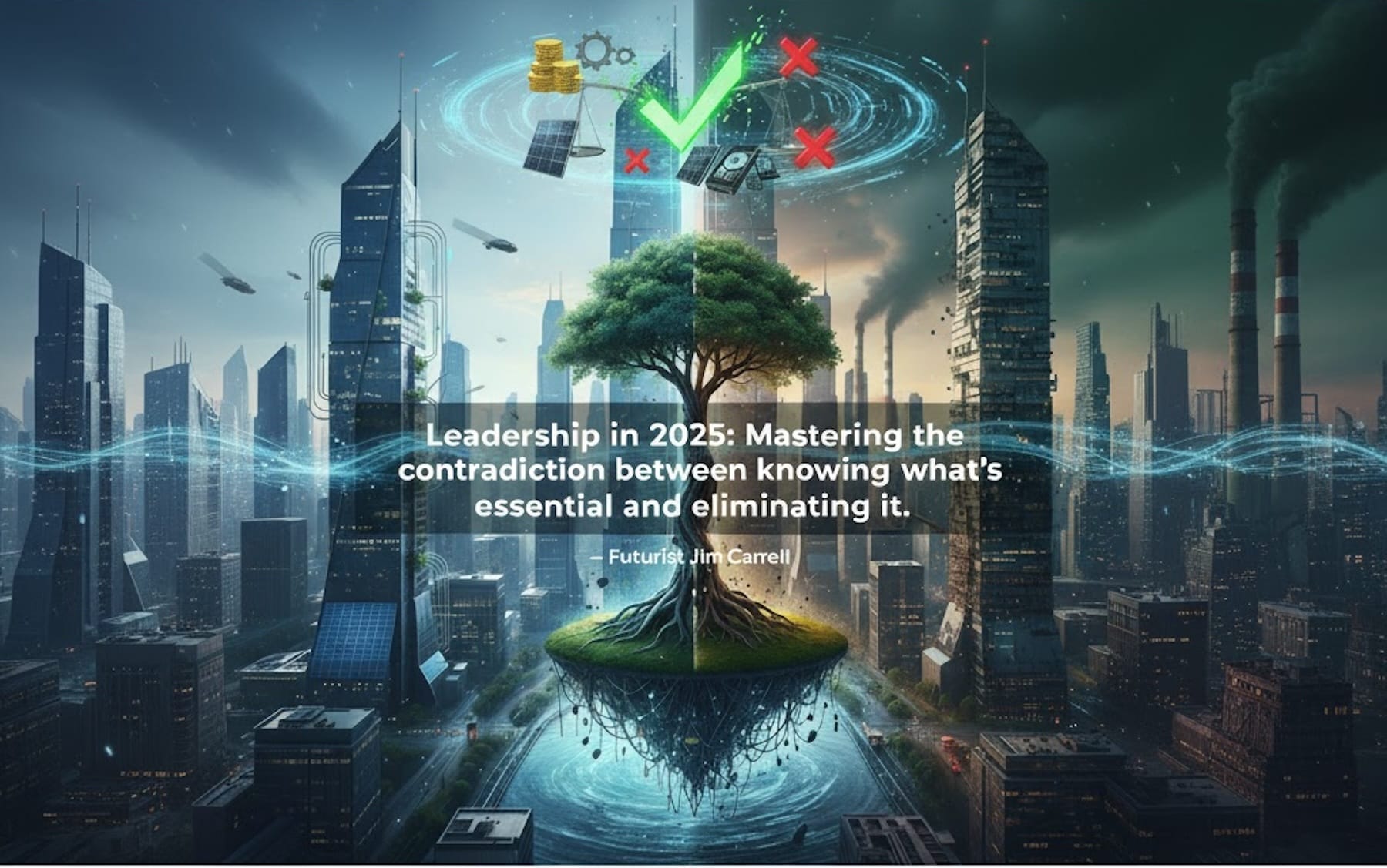
If anything is real in 2025, it is the fact that organizations have mastered the art of saying one thing and doing another - often with a pretty negative intent. No wonder people are jaded, confused, wound up, and upset.
Think about it. Organizations worldwide face an existential contradiction: the very investments needed to survive the future are being slashed to survive the present. The goals they set to live up to some pretty vast challenges have been torn asunder or set aside.
And the fact is, this "say-do gap" is everywhere. (That's the gap between what they 'say' they will do, and what they actually 'do.') I used Claude.AI and Google Gemini to do a deep research analysis of what's going on, and both came back with some pretty intense reading. I then used Gamma. App to summarize this into two slide decks - one generic, and one specific.
The first, "The 2025 Paradox Report: 50 Contradictions Between Corporate Rhetoric and Reality", will give you a pretty quick idea of the nature of the gap.
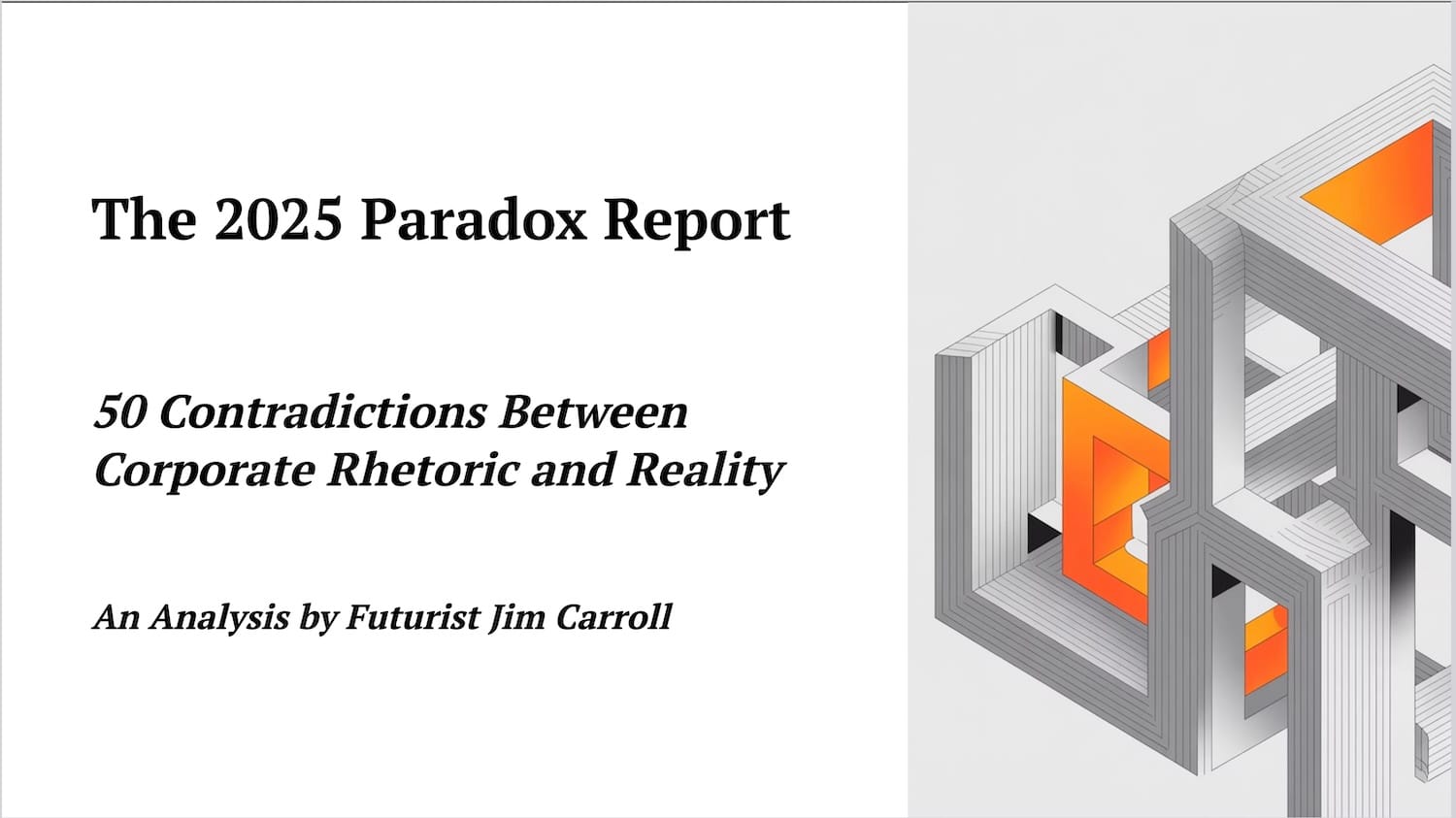
To give just one example from that document:
"Organizations publicly declare workforce development as essential while simultaneously gutting the very programs and people needed to build future capabilities, creating a widening gap between skills rhetoric and investment reality.
I easily came up with 50 such contradictions. Give it a read - it's pretty stark.
The second one gets a little more specific - The Preparedness Paradox: How Organizations Are Cutting the Very Investments They Need to Survive the Future is an even more sobering read.
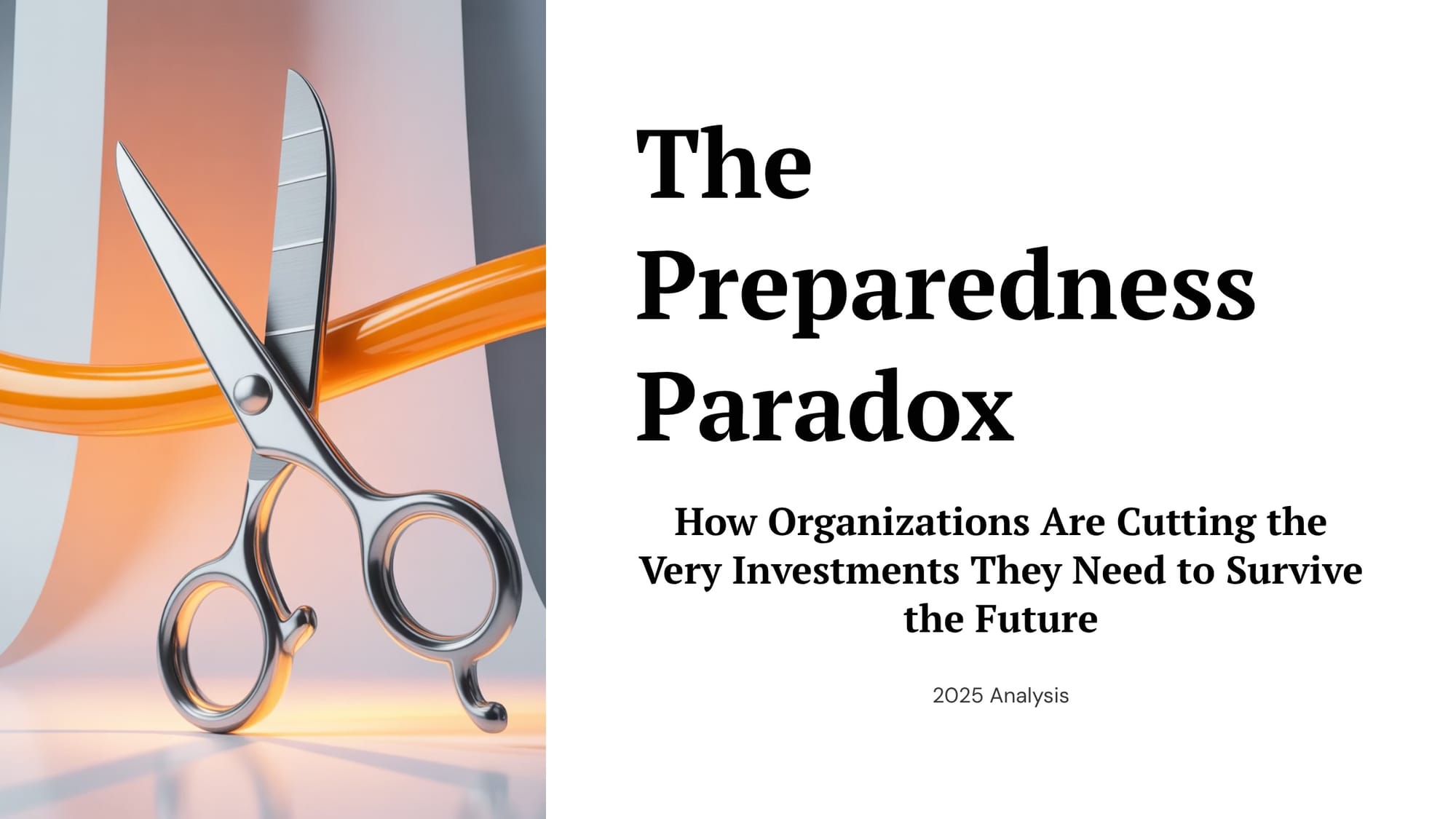
This one gets into actual corporate stories and observations., I ran the PDF through multiple AI systems for a fact check, and it's pretty spot on. Consider the major contradiction between the escalating cybersecurity crisis and the slowing budget growth.
Key points of the crisis in 2024 include:
- The number of breached accounts increased eightfold to 5.5 billion.
- The average cost of a data breach rose by 10% to $4.88 million, reaching an all-time high of $9.36 million in the U.S.
- The healthcare sector alone saw 276.7 million records exposed.
Despite these worsening threats, the growth of security budgets slowed to only 8% in 2024.
Say-do!
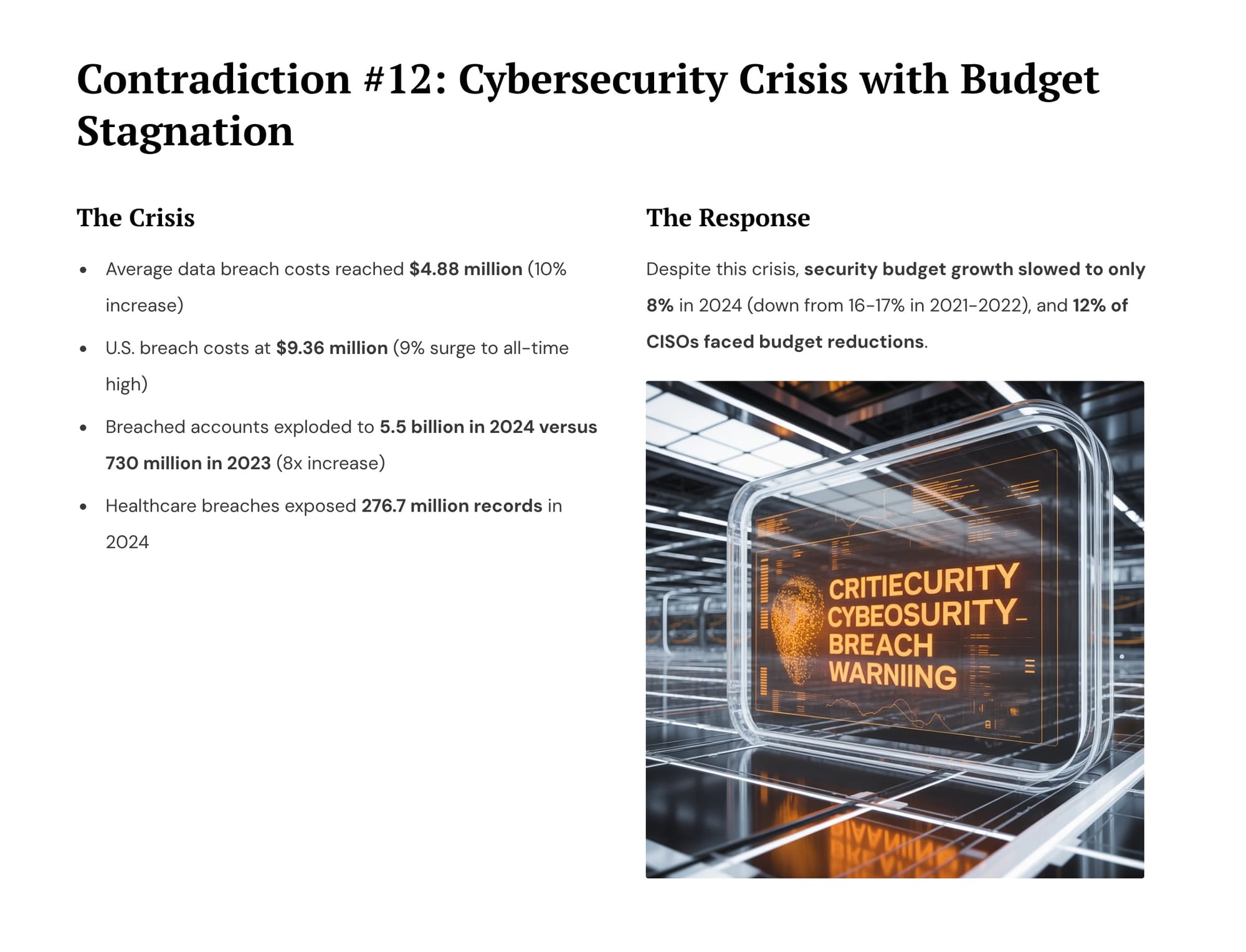
The data reveals a troubling pattern: massive tech worker layoffs while companies claim AI skills are critical; training budgets declining by nearly a fifth per employee amid skills gap rhetoric; astronomical increases in fossil fuel financing despite net-zero pledges; and thousands of retail store closures projected while omnichannel investment explodes. This isn't just belt-tightening—it's a fundamental failure to align actions with acknowledged imperatives, creating a vicious cycle where cost-cutting today guarantees crisis tomorrow.
Sure, here is the list without citations.
- The AI Talent Paradox: Publicly declaring a desperate need for AI talent while simultaneously laying off thousands of experienced tech workers who could be retrained to fill those roles.
- The Skills Gap Myth: Bemoaning a critical workforce skills gap while actively cutting corporate training budgets and eliminating internal development programs.
- The Mass Layoff Contradiction: Insisting on a national "talent shortage" to explain hiring difficulties while conducting historic mass layoffs and maintaining a "true" unemployment rate of over 24%.
- Cybersecurity Disinvestment: Stagnating or cutting cybersecurity budgets even as the frequency, severity, and financial cost of data breaches reach all-time highs.
- Resilience Amnesia: Abandoning investments in supply chain resilience just a few years after a global pandemic demonstrated the catastrophic cost of fragile systems.
- Public Health Defunding: Slashing federal budgets for pandemic preparedness and public health immediately following a devastating global pandemic.
- The Net-Zero Reversal: Major banks publicly withdrawing from global climate alliances while simultaneously increasing their financing of fossil fuel projects.
- The Green Energy Pivot: An energy giant reversing its climate pledges by cutting renewable energy investments to fund expanded oil and gas production.
- Pharmaceutical Innovation Cuts: Slashing pharmaceutical R&D spending—the primary engine of future medical breakthroughs—as a core cost-cutting strategy, with R&D margins expected to decline significantly.
- The Empty Office Mandate: Forcing rigid return-to-office mandates despite clear data showing they harm productivity and increase employee turnover.
- The Digital Transformation Pause: Proclaiming digital transformation as an urgent priority while simultaneously pausing new spending on it, even with fully allocated budgets.
- The DEI Reversal: Systematically eliminating diversity, equity, and inclusion programs after years of promoting them as core corporate values, often in response to political pressure.
- The Healthcare Access Crisis: Accelerating the rate of hospital closures, particularly in poor and vulnerable communities, when the need for robust health infrastructure is most apparent.
- The Omnichannel Contradiction: Closing a record number of physical stores to cut costs, even as the booming omnichannel retail market requires a physical presence to succeed.
- The AI Pilot Purgatory: Leading all other industries in piloting new AI projects while failing catastrophically to scale them beyond the pilot stage.
- The Retraining Fallacy: Paying extreme salaries to hire new AI talent while laying off thousands of existing tech workers who could be retrained for a fraction of the cost.
- The Single-Supplier Déjà Vu: Reverting to single-supplier relationships to save money, directly recreating the vulnerabilities that caused recent global disruptions.
- The Clean Energy Cancellation: Canceling billions in planned clean energy and EV manufacturing projects, directly undermining stated national climate and industrial goals.
- The Inventory Buffer Burn: Intentionally eliminating inventory safety buffers to improve short-term cash flow, guaranteeing greater vulnerability to the next supply shock.
- The AI Customer Service Illusion: Cutting thousands of human customer service jobs while claiming the move to AI will "enhance" the customer experience.
- Automotive R&D Retreat: Reducing automotive R&D investment at the exact moment global competition from faster, more innovative manufacturers threatens market share.
- The Carbon Goal Erasure: A major corporation abruptly abandoning all its publicly stated carbon-emissions goals after making them a core part of its brand identity.
- The Precision Agriculture Trap: Farmers facing record debt that prevents them from investing in precision agriculture technology proven to increase yields and lower costs.
- The Layoff-and-Learn Hypocrisy: Announcing mass layoffs while simultaneously promoting a corporate culture centered on internal retraining and workforce development.
- The Retail Apocalypse Paradox: Witnessing a surge in retail bankruptcies and store closures, even as aggregate economic data shows strong consumer spending.
- The "Responsible AI" Smokescreen: Publicly committing to "Responsible AI" principles while lobbying to weaken or delay AI safety and privacy regulations.
- Performative Wellness: Investing heavily in employee wellness apps while fostering a culture of overwork, burnout, and increased surveillance.
- The Experience Paradox: Championing "skills-based hiring" while simultaneously requiring multiple years of experience for 35% of "entry-level" positions.
- Shareholder Over Worker: Executing record-breaking stock buybacks to boost share prices while real wages for the median worker remain stagnant at just 0.7% growth.
- Biodiversity-Washing: Adopting "nature positive" language in sustainability reports without funding credible measurement or verification to back it up.
- The Deregulation Gambit: The financial industry lobbying for weaker capital requirements and deregulation after posting record profits in a volatile market.
- The AI Ethics Team Evaporation: Tech companies dismantling their AI ethics and safety teams at the precise moment their products become more powerful and integrated.
- The AI Surveillance Rebrand: Promoting AI-powered productivity tools that increase employee surveillance and stress under the guise of "wellness" and "support".
- The "True" Unemployment Gap: Claiming a "labor shortage" with a 4.3% unemployment rate, while the "true" rate, including the underemployed, remains over 24%.
- The Misinformation Hypocrisy: Publicly denouncing misinformation while paying to run political ads on platforms known to amplify extremist and false content.
- Environmental Hypocrisy: European chemical plants closing due to policy costs, only to have high-emission imports fill the market gap.
- The Sustainable Consumer Gap: Consumers expressing a strong desire for sustainable products but consistently prioritizing price and convenience in actual purchasing behavior.
- The Private Equity Squeeze: Increasing private equity "roll-ups" of physician practices, which leads to higher costs and reduced access to care for patients.
- The Privacy Trade-Off: Companies lobbying against data privacy laws while consumers increasingly give up personal data for AI-powered convenience.
- Performative Activism: Publicly condemning authoritarian surveillance while accepting job offers from data-mining firms that enable it.
- The Free Speech Façade: Promoting a corporate mission of creative freedom while suppressing internal dissent on politically sensitive issues.
- Green-Hushing: CEOs speaking less about sustainability to avoid political backlash, despite continuing internal action on ROI-positive green initiatives.
- The Scope 3 Failure: Acknowledging that half of all companies are behind on their Scope 3 emissions targets, revealing a systemic failure in decarbonization.
- The Supply Chain Talent Gap: Investing in AI to improve logistics efficiency while the talent gap for skilled supply chain professionals widens to critical levels.
- The Overqualification Penalty: Rejecting job applicants for being "overqualified," effectively penalizing experience in a supposed "talent shortage".
- Algorithmic Bias: Using AI-powered hiring tools that perpetuate historical biases, despite public commitments to equitable hiring practices.
- The Buyback Concentration: The number of companies announcing stock buybacks hitting a 10-year low, while the total dollar value of those buybacks hits an all-time high, concentrating wealth.
- The VOI Obfuscation: Shifting from Return on Investment (ROI) to "Value on Investment" (VOI) for wellness programs, obscuring the lack of tangible health outcomes.
- The Supplier Diversity Squeeze: Expanding supplier diversity programs while simultaneously rationalizing the supply base to fewer, larger partners, undermining the initiative.
- The Third-Party Resilience Risk: Increasing reliance on third-party tech vendors, creating single points of failure, while claiming to enhance operational resilience.
What do you do with this insight?
I'm not sure.
I'm a futurist. I cover trends.
The say-do gap is a very real trend.
Do with it what you will.
Futurist Jim Carroll believes we are living through the era of 'shallow leadership' - a time when many organizations have lost the very essence of any type of corporate social responsibility. The extent of the damage will be evident in the years to come.

